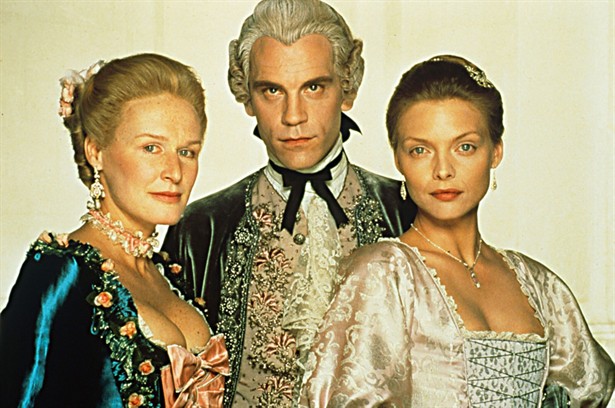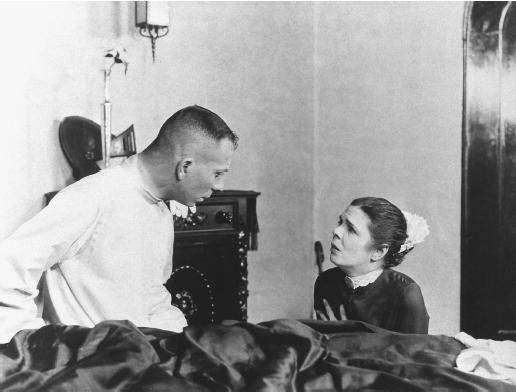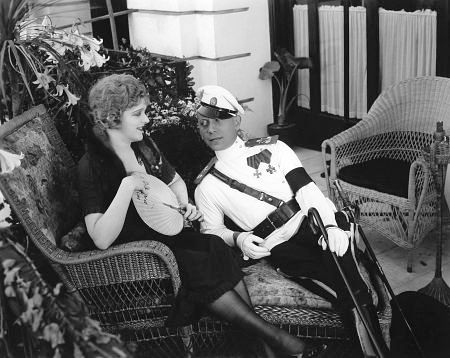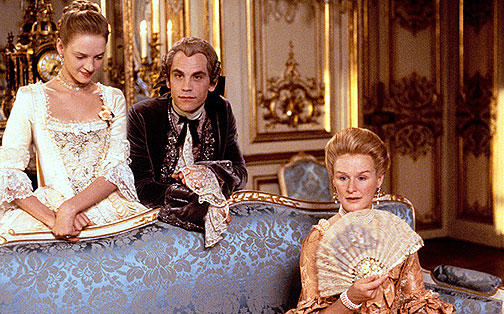From the Chicago Reader (January 20, 1989). — J.R.
DANGEROUS LIAISONS
** (Worth seeing)
Directed by Stephen Frears
Written by Christopher Hampton
With Glenn Close, John Malkovich, Michelle Pfeiffer, Swoosie Kurtz, Keanu Reeves, Mildred Natwick, and Uma Thurman.
Choderlos de Laclos’ Les liaisons dangereuses, first published more than 200 years ago, is one of the greatest novels ever written, but one would never guess it from the watchable but shallow comedy-melodrama of manners that Christopher Hampton and Stephen Frears have extracted from it. They’ve stuck fairly close to the general outlines of the original plot, but they’ve jettisoned the form entirely, so that what remains is a distortion as well as a simplification of what is conceivably the best French novel of the 18th century.
Admittedly, Roger Vadim’s updated French film adaptation of 30 years ago, set partially at a contemporary ski resort, was no less reductive, and a third film version presently being prepared by Milos Forman, Valmont, is unlikely to avoid similar problems. Laclos’ 1782 masterpiece is an epistolary novel consisting of 175 letters written by at least ten separate characters, preceded by a “Publisher’s Note” and an “Editor’s Preface” and accompanied by several “editorial” footnotes throughout — an intricate dialectical construction that offers us several independent and often contradictory versions of practically everything that happens, and more than one interpretation of what all the various events mean.
Even the highly ironic prefatory material partakes of this dialectical complexity, ensuring that no single voice in the novel ever has privileged access to the truth. In the “Editor’s Preface” Laclos claims that the letters are selected from an authentic correspondence, and that they are being published because “It appears a service rendered to good morals to unmask the methods employed by those whose morals are bad, in corrupting others who are good.” But in the so-called “Publisher’s Note” — which in fact was also written by Laclos — the fictional publisher argues that the letters are entirely fictitious, that they couldn’t possibly have been written in France in the 18th century: “Our opinion . . . is that if the events recorded in this work have a basis in truth they could only have happened in other countries or in other times.”
The screenplay of Dangerous Liaisons, freely adapted by Hampton from his stage version of the book (which I haven’t seen), reportedly reduces the play’s running time by 40 minutes while restoring more of the plot from the novel. The film begins with a sumptuous account of the two leading characters, the Marquise de Merteuil (Glenn Close) and the Vicomte de Valmont (John Malkovich), being wakened and attended to by their many servants in their separate Parisian residences. It hardly seems coincidental that the only theater where the movie is currently playing in Chicago, the Cineplex Odeon at 900 North Michigan, is virtually located in Bloomingdale’s basement, and that one of the audiences I saw the film with, on its Friday night opening, seemed to consist largely of potential Bloomingdale’s customers. The beginning sequence is strictly a consumerist fantasy designed to elicit oohs and aahs from a relatively upscale audience about how luxuriously these characters live, with a certain built-in irony about the extravagance on view that permits an audience to laugh at it and identify with it at the same time. Frears, it should be noted, is an English director with a reputation for being leftist and antiestablishment, most recently because of his direction of My Beautiful Laundrette, Sammy and Rosie Get Laid, and Prick Up Your Ears; but this project is devoted from the outset to flattering and pandering to the same well-to-do art-house audience that flocked to Peter Greenaway’s The Draughtsman’s Contract. This doesn’t necessarily invalidate what the movie sets out to do, but it does circumscribe its intentions in a context that is quite different from Laclos’.
Merteuil and Valmont are certainly the villains here, as they are the villains of the novel, but the movie gives them a centrality and a privileged status in relation to the story that seem quite out of keeping with the strategies of the original. Former lovers who devote most of their time and energy to plotting various seductions out of spite and/or amusement, they form a pact at the beginning of the story that sets the plot in motion.
Merteuil has recently been spurned by Monsieur le Comte de Bastide (a character with never appears), who has left her to become engaged to a virgin named Cecile de Volanges (Uma Thurman). So she asks Valmont to seduce Cecile, so that Bastide will wind up with a deflowered bride. Valmont, however, dismisses this project as too easy and therefore beneath his station as a notorious rake. The project that currently interests him is seducing one Madame de Tourvel (Michelle Pfeiffer), a deeply religious bourgeoise who is staying at the country estate of Valmont’s aunt, Madame de Rosemonde (Mildred Natwick), while her husband is off “presiding over some endless case in Burgundy.” To persuade Tourvel to betray everything that she believes in, Valmont explains, is a much worthier ambition for his talents than the callow Cecile; he also expresses an interest in renewing his affair with Merteuil.
Merteuil gamely agrees to sleep with Valmont if he succeeds not only in seducing Tourvel, but also in securing a written confession from her about her indiscretion. Meanwhile, to further her own plans of revenge against Bastide, Merteuil, who has become the confidante of the young Cecile, persuades Cecile’s mother, Madame de Volanges (Swoosie Kurtz), to hire the handsome music teacher Chevalier Danceny (Keanu Reeves) to give Cecile music lessons, hoping that Danceny will eventually seduce her.
Danceny and Cecile wind up falling in love; they exchange love letters (some of which are delivered by Valmont), but no seduction takes place. So eventually Valmont takes time off from wooing Madame de Tourvel to deflower Cecile himself, using his role as messenger to acquire a key to her bedroom, and then using blackmail (threatening to reveal that she’s given him the key) in order to ensure her compliance.
These are only a few of the machinations of Merteuil and Valmont, who plan and orchestrate their intrigues like military operations. (This becomes explicit toward the end of both novel and film, when Valmont interprets a refusal of Merteuil as “a declaration of war.”) Laclos himself was a military man who was involved in diverse political intrigues, being attached at various times to the Duc d’Orleans (and a plot to dethrone Louis and Marie Antoinette on his behalf), the Jacobins, the French possessions in India, and Napoleon’s army (where he served as general of artillery). The elaborate calculations and moves of his villains may reflect some of this experience, which has prompted some critics to a label him the Machiavelli of the boudoir.
Valmont and Merteuil are both characters obsessed with power and their own vanity, and part of the brilliance of Laclos’ only novel is its success in making them wholly real as well as wholly evil. (Andre Gide noted of Laclos, “There is no doubt as to his being hand in glove with Satan,” and if making evil real rather than conjectural makes evil more possible in the world outside art, Gide may have a point.) In the novel their reality is largely created by the rounded view that we get of them through letters and accounts from the other major characters, and the reality of these other characters is similarly created through multiple views. It may sound anachronistic to say so, but the novel is essentially constructed on cubist principles, and a truly “faithful” adaptation would probably be something closer to Last Year at Marienbad than to Hampton and Frears’s Masterpiece Theater version.
The major limitation of Dangerous Liasons, in short, is that it presents us only with theatrical, frontal views of Merteuil and Valmont, and reduces the rest of the characters to the status of pawns or props. In the novel, Cecile, her mother, Danceny, the pious Madame de Tourvel, Valmont’s aunt Rosemonde, and others, are all permitted to step into the foreground at various junctures and reveal their own interpretations of what is going on. While the villains usually come off as being more clever than the characters they manipulate and victimize, one is never made to feel that the entire cast of characters is split between predators and bimbos. But this is more or less the impression that the movie conveys, with the sole and incidental exception of Rosemonde, who seems to have some idea of what’s going on.
The gradual capitulation of Madame de Tourvel to Valmont, for example, which takes place in the novel over hundreds of pages, is barely charted at all in the film. It simply happens, and in order for the spectator to believe in it, the character of Madame de Tourvel has to be regarded as a simple-minded fool. In the novel, one letter from Valmont to Merteuil boasting of his progress with his recalcitrant prey is followed by a letter from Madame de Tourvel to a friend revealing that Valmont is vainly deluding himself — she sees through his hypocrisies, and contrary to his claims to Merteuil, he hasn’t yet gotten to first base with her.
No such contradictions or detours are permitted in the movie, where the action proceeds exclusively in one direction, and the evident superiority of Valmont and Merteuil to their victims makes it more strictly a cat-and-mouse affair. The main effect of this change is to mythologize the villains while trivializing almost everyone else. The basic moves of the plot are faithfully adhered to — which guarantees a steady and compelling narrative — but most of the moral ambiguities and intricacies are stripped away, and what remains is at times closer to farce than to tragedy or melodrama. The shallowness of the film’s space, which seems to reflect Frears’s extensive work in TV drama, points to an equivalent reduction: plentiful close-ups of Close and Malkovich gloating under heavy makeup substitute for a camera style that would emphasize interactions between characters; likewise, interior decoration often takes the place of social context.
Some of these problems would undoubtedly arise in any attempt to dramatize an epistolary novel, which makes one wonder whether Milos Forman’s forthcoming Valmont will fare any better. Les liaisons dangereuses is conceived in part as a detailed response to Richardson’s Clarissa and Rousseau’s La nouvelle Heloise, both of which are discussed by characters in the novel. The form presupposes a kind of leisure and reflection that is not easily translatable into snappy movie dialogue, so Hampton and Frears can be excused to some extent for isolating certain brief passages from the original and giving them the status of one-liners.
But the effect this has on the story’s meaning still raises certain doubts. Perhaps the most remarkable letter in the novel, the 81st, is Merteuil’s detailed account to Valmont of the sources of her amorous strategies and attitudes — a fascinating apologia that has distinct feminist overtones concerning the relative powerlessness of women. By extracting a few choice snippets from this letter and introducing them quite early in the film, in the first scene between Merteuil and Valmont, the filmmakers seem to be dispensing with this material rather than honoring it with a more strategic position in the narrative, as Laclos did. The truth of this becomes painfully evident when the movie winds up sentimentalizing Valmont’s eventual comeuppance in order to make his defeat seem more noble — complete with well-placed and carefully timed glycerine tears sliding down his cheeks — while the comeuppance of Merteuil, even though it omits the novel’s detail of her contracting smallpox, allows her no such dignity or sympathy. The net result of these tactics, along with the more drastic reduction of all the other female characters, is to make the movie actively misogynistic in a way the novel is not.
I suspect that the only filmmaker who might have been able to do justice to Laclos’ novel would have been the great Eric von Stroheim, whose 1922 masterpiece, Foolish Wives, even in its surviving truncated state, hints at some of the dark passions, demonic furies, interpersonal dynamics, psychological density, and elegant style that Laclos was able to set in motion. Without the creative genius of a Stroheim, the best we can hope for is intelligent reduction, and this is what Hampton and Frears fitfully provide. While no one in the cast has an authority to match that of 83-year-old Mildred Natwick, as Valmont’s aunt Rosemonde, Glenn Close manages to mix a fair amount of fire, brimstone, and crushed ice into her macabre smiles, and John Malkovich continues to demonstrate the craft of a first-rate stage actor who has not yet managed to scale his talent to the dimensions of a movie screen. All things considered, they put on a decent show, but the excruciating power of the novel is nowhere in sight.








